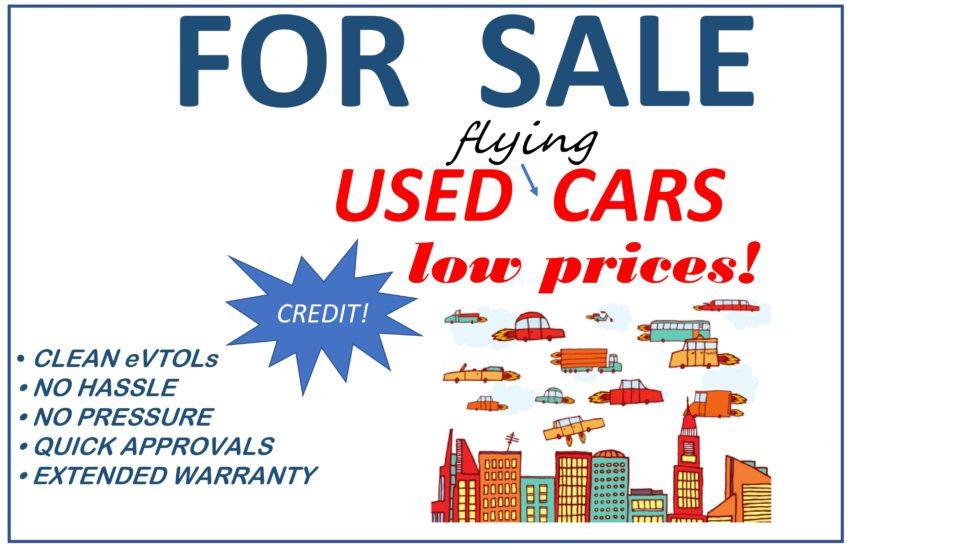For Sale: Used Flying Car

The first eVTOL has yet to be certified, we know that. But, the day is coming. As sure as there will be flying cars for sale around the globe, soon after, there will be used flying cars for sale.
While the anticipated prices for most of these new aircraft is anywhere from about US$400,00 and up, how much will a used eVTOL cost and what will determine its value?
The current resale market for used airplanes and helicopters may provide some guidance.
Appraising eVTOLs for Resale Value
On average, an aircraft owner begins to consider selling their vehicle at around three years of ownership according to Paul Irvin, an appraiser with the Professional Aircraft Appraisal Organization. Several factors will be likely taken into account, including the original purchase price and whether the aircraft’s avionics are standard equipment for that model or if they’ve been upgraded. If upgraded, what’s the value of that package in the current market? Is the aircraft damaged in any way; if so, has the damage been repaired properly?
With upgraded avionics, an aircraft may be worth more than a new aircraft of the same type that only has the original equipment manufacturer’s (OEM’s) systems. Appraisers looking at eVTOLs in the future will also consider market studies of that particular aircraft, whether it’s part of a fleet, and how many airborne hours it has under its wings. They will also want to know if it’s time for the vehicle’s power plant to be updated or overhauled.
If the aircraft is due for an overhaul after 2,000 hours of flight time and the vehicle under consideration has 1,900 hours on it since the previous maintenance work, who pays for that – buyer or seller? Those same 1,900 hours will factor into the value equation appraisers will use.
What’s the Warranty for a Used Flying Car?
Most of the eVTOLs being designed today have propellors. What shape are those rotors in? Are they fixed pitch or variable pitch? How about the brushes in the electric motor, do they need to be changed? The wear of each blade, numbers 1-5, will be examined as part of the appraisal process.
A car up for resale may have been driven on the freeway most of its life; others may have been subjected to the rigors of stop-and-go traffic. Likewise, buyers of a used eVTOL will want to consider how the wear-and-tear of frequent takeoffs and landings might impact the future life expectancy of the vehicle.
Other factors include the condition of the landing gear and the appearance of the interior and exterior. “How does the paint look?” Irwin might ask. “Is it pristine? Could you rate this vehicle a 9 or 10 out of 10? Is it in ‘museum quality’ condition? Are there dings or scratches on the body?” If there’s damage, an appraiser will need to factor in the cost of repairs when calculating the vehicle’s value.
Also helpful, Irwin says, is the plane’s documentation; not only for accuracy – who the previous owners were, but also for potential celebrity value. Did a Hollywood star or a world leader sit in the pilot or passenger seat? Was it part of a fleet, as might be the case with an air taxi operator? And, where was this aircraft used predominantly? In the U.S., South America, Asia, Canada? Car owners in the U.S., for example, know the effects harsh winters and humidity can have on a vehicle compared to cars driven in the milder climates.
A typical appraisal evaluation can take about five days to complete. If it was a special use aircraft, such as a Chipmunk used by the RAF post-WWII, that might add value too.
Will you have a trade-in eVTOL that’s part of your deal? There are lots of questions still to be answered around urban air mobility. Someday, one of them will be “What’s my flying car worth?”
Want to continue to stay up-to-date about the latest developments in the eVTOL industry? Subscribe to AeroCar Journal now. It’s FREE (for a limited time)!
Join us on Twitter for the latest news, analysis, and insight in the eVTOL industry. AeroCarJ


